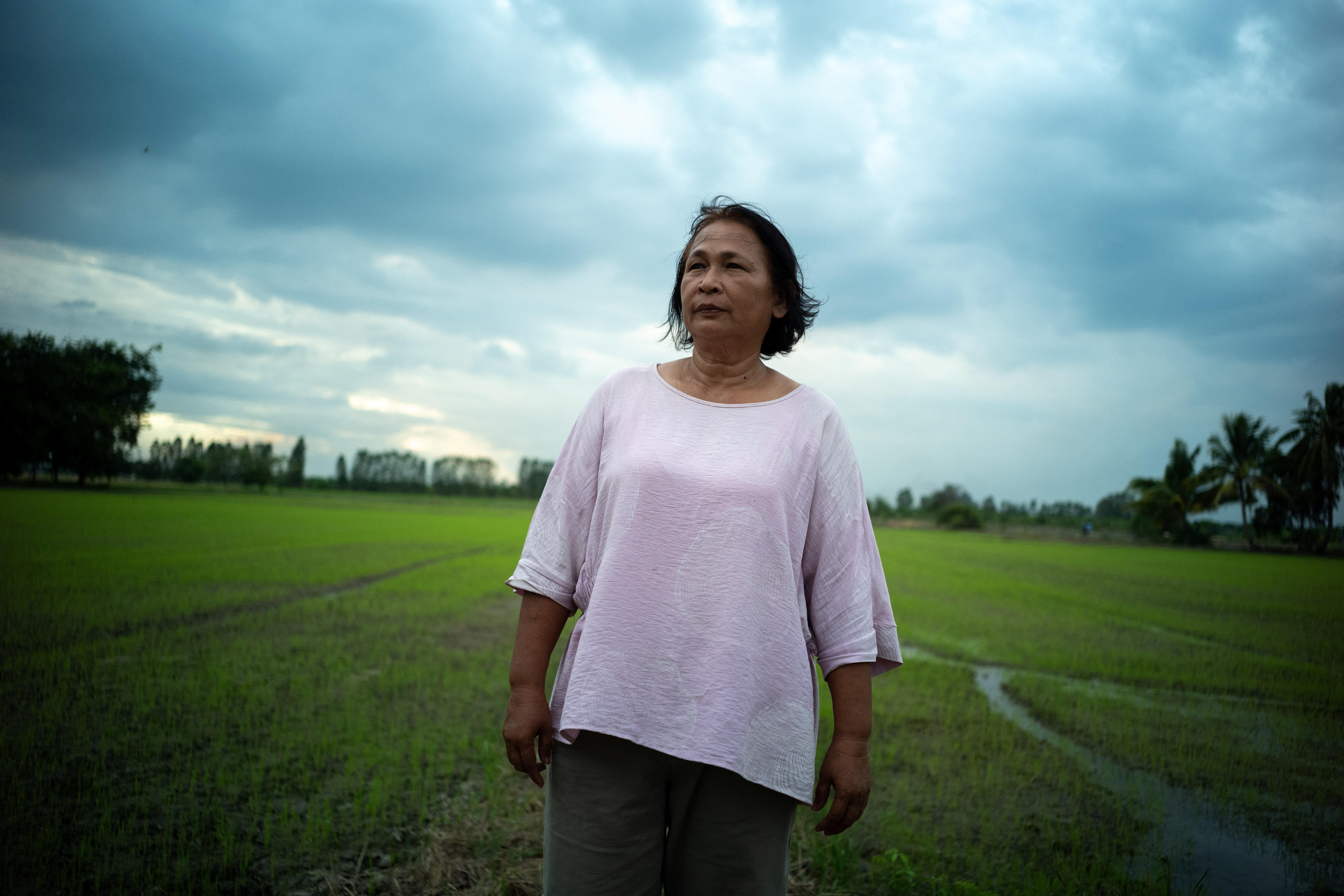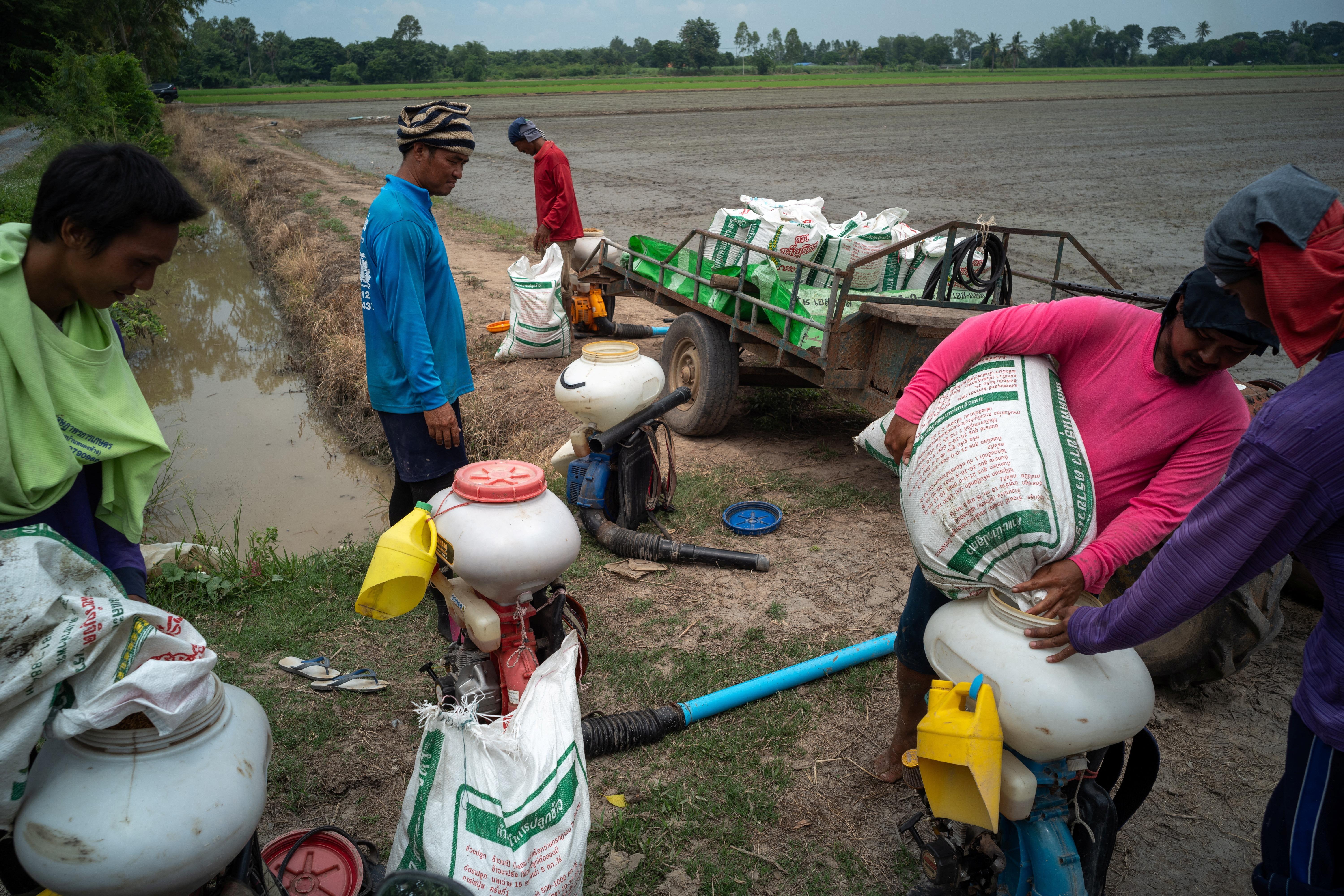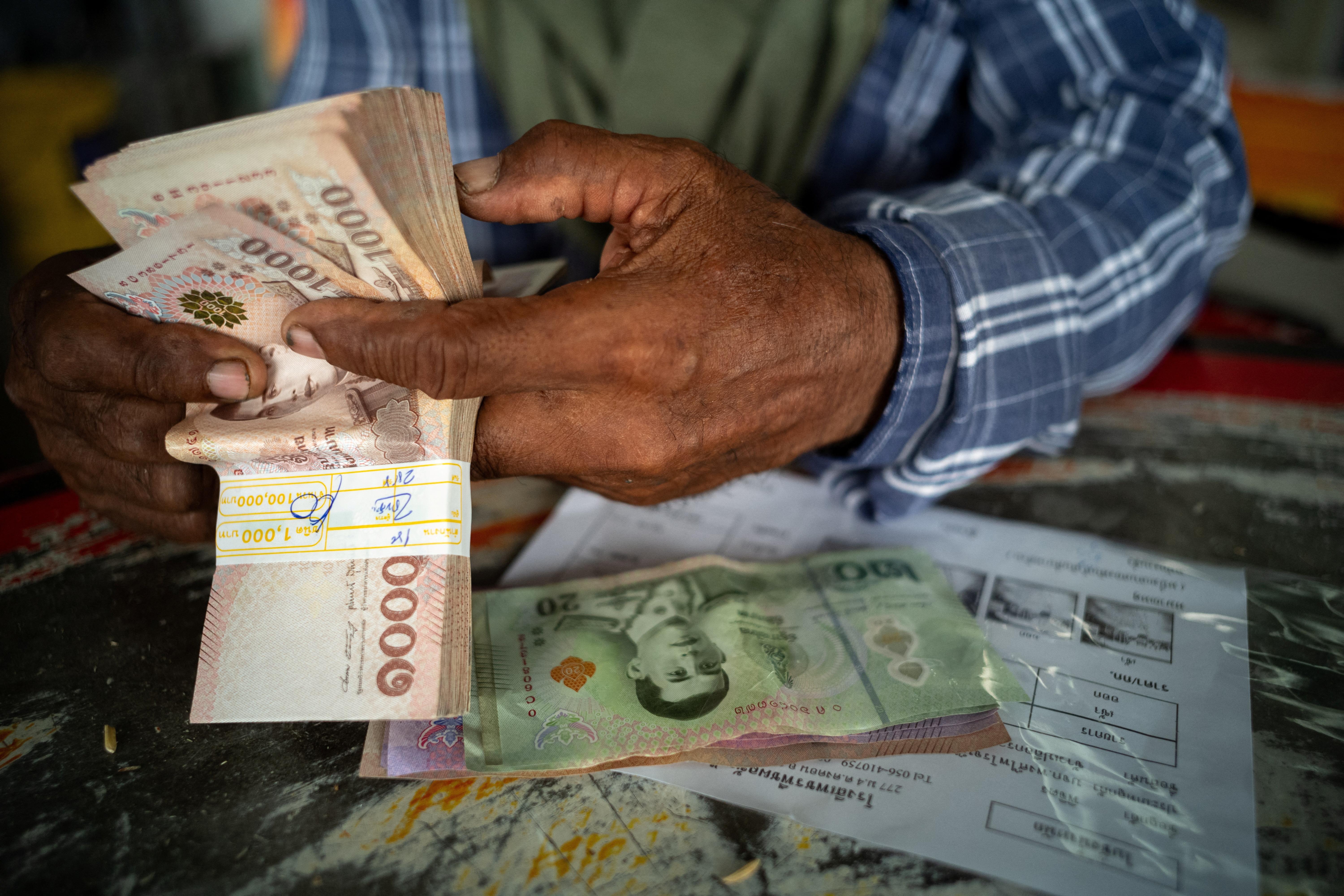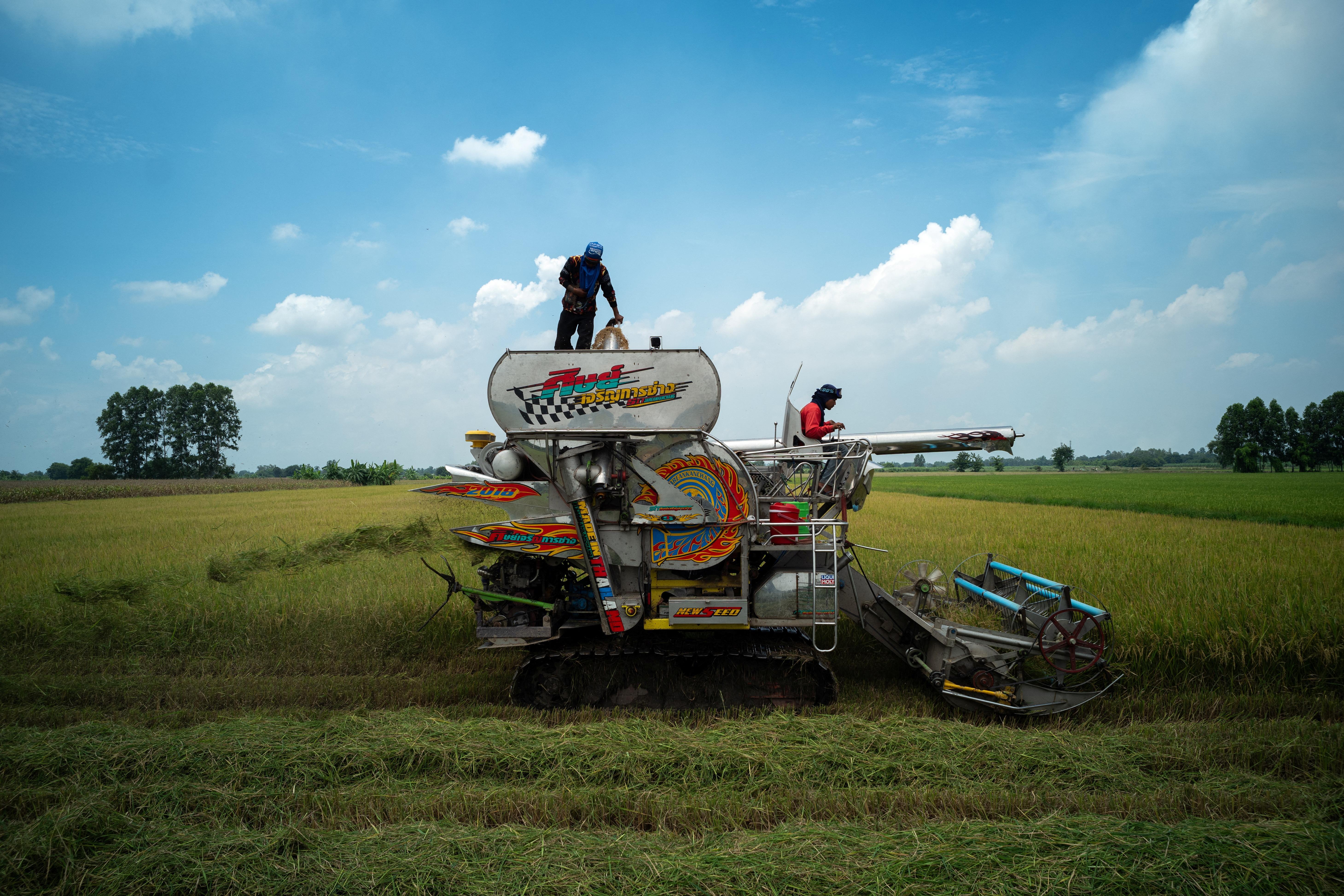 Farmers harvest rice in a field in Chainat province, Thailand, August 31, 2023. (PHOTO / REUTERS)
Farmers harvest rice in a field in Chainat province, Thailand, August 31, 2023. (PHOTO / REUTERS)
CHAI NAT - After finishing her latest rice harvest, Sripai Kaeo-eam hurriedly cleared her fields and planted a new crop in late August — ignoring a Thai government advisory to restrict further sowing of the grain this year to conserve water.
"This crop is our hope," said the 58-year-old farmer in Thailand's central Chai Nat province, pointing to her green paddy seedlings only a few inches tall.
 Sripai Kaeo-eam, 58, a farmer who is struggling to repaying her loans, poses in front of her rice field during an interview with Reuters in Chainat province, Thailand, August 30, 2023. (PHOTO / REUTERS)
Sripai Kaeo-eam, 58, a farmer who is struggling to repaying her loans, poses in front of her rice field during an interview with Reuters in Chainat province, Thailand, August 30, 2023. (PHOTO / REUTERS)
Sripai, who is trying to dig her way out of more than 200,000 Thai baht ($5,600) of debt, is motivated by the global spike in rice prices, which are close to their highest level in about 15 years after India — the world's biggest shipper of the water-intensive grain — curbed exports.
Farmers across the agrarian heartland that makes Thailand the world's second-largest rice exporter should be poised to benefit.
ALSO READ: PM: Thailand to roll out more populist policies this year
The amount of land under rice cultivation in Thailand decreased 14.5 percent in August compared to the same month last year, according to previously unreported government estimates. The figure has declined every year since 2020.
A drop in cultivated land could slash Thailand's rice output, adding to already rampant food inflation after drought conditions in other key rice-producing countries and hitting billions of consumers for whom the grain is a staple food, said agricultural expert Somporn Isvilanonda
Thailand's centuries-old rice cultivation system is under severe stress from climate change, unsustainable farm debts and a lack of innovation, according to interviews with two experts and a review of government data.
Farmers across the agrarian heartland that makes Thailand the world's second-largest rice exporter should be poised to benefit.
READ MORE: From rice to wheat, Asian crops forecast lower as El Nino worsens
Instead, the amount of land under rice cultivation in Thailand decreased 14.5 percent in August compared to the same month last year, according to previously unreported government estimates. The figure has declined every year since 2020.
Thailand's centuries-old rice cultivation system is under severe stress from climate change, unsustainable farm debts and a lack of innovation, according to interviews with two experts and a review of government data.
A drop in cultivated land could slash Thailand's rice output, adding to already rampant food inflation after drought conditions in other key rice-producing countries and hitting billions of consumers for whom the grain is a staple food, said agricultural expert Somporn Isvilanonda.
Thailand exported 7.7 million tonnes of milled rice in 2022 to countries across the Middle East, Asia and Africa, according to Krungsri Research.
 Farmers prepare for paddy seeding in a rice field in Chainat province, Thailand, August 31, 2023. (PHOTO / REUTERS)
Farmers prepare for paddy seeding in a rice field in Chainat province, Thailand, August 31, 2023. (PHOTO / REUTERS)
"The cultivated area is down because of lack of rainfall and irrigated water," said Somporn, a senior fellow at the state-affiliated Knowledge Network Institute of Thailand (KNIT).
The water shortage is likely to worsen into 2024 as the dry El Nino weather phenomenon strengthens, according to government projections.
On the line for millions of farmers is not only their current crop, but a narrow window to escape a life crushed by debt. A good harvest could fetch prices that are up to double or triple that of most years, Sripai said.
"Now I am dreaming," she said, "because India has stopped exporting."
The Thai government's rice department did not respond to questions sent by Reuters.
READ MORE: Thailand says no rice export halt, to benefit from India's export ban
Rice is central to Thailand. A little under half its farmland is marked for rice cultivation, with over five million households involved, according to Krungsri.
Successive governments have spent 1.2 trillion Thai baht ($33.85 billion) on price and income interventions for rice farmers in the last decade, estimates Somporn.
"But the government didn't do enough ... to improve productivity," he said.
Though prices are now high, "farmers cannot take the opportunity to produce rice," Somporn said, adding that he expected output to drop around 30 percent over the next two growing seasons due to the water shortage.
 A farmer counts money after he sells his rice to a mill in Chainat province, Thailand, August 29, 2023. (PHOTO / REUTERS)
A farmer counts money after he sells his rice to a mill in Chainat province, Thailand, August 29, 2023. (PHOTO / REUTERS)
Debt and drought
On a sweltering August morning, dozens of farmers and landowners protested outside a state-run agricultural bank in Chai Nat, where they had waited overnight to meet officials.
Danai Saengthabthim, 60, was among those at the hours-long meeting, where he sought to convince officials not to seize his land for failing to repay debts that have swelled over two generations.
The Bank for Agriculture and Agricultural Cooperatives said it does not have a policy of confiscating land from farmers who unintentionally default.
He is now pinning his hopes on Thailand's new coalition government for help. "The debt has just kept increasing over time," he said.
Thailand has one of Asia's highest household debt levels. In 2021, 66.7% of all agricultural households were in debt, largely from farming-related activities, according to government data
Even before the new government took office, Sripai and other farmers from the region made repeated trips to the capital, Bangkok, to lobby the agriculture ministry.
"All the farmers in our group have debts," said Sripai, who pays a rate of 6.875 percent on her loan. "We got the debt when we faced droughts, floods, and pests."
Thailand has one of Asia's highest household debt levels. In 2021, 66.7 percent of all agricultural households were in debt, largely from farming-related activities, according to government data.
Prime Minister Srettha Thavisin said in his first policy statement before parliament last week that the government will seek to improve farm incomes.
"There will be a consolidation of water management resources, innovations ... to increase yields as well as finding new markets for agriculture product," he said, adding that there would also be a moratorium on some farm loans.
READ MORE: Thai households struggle with record debt, virus adds to burden
"Extreme weather patterns brought on by the El Nino phenomenon are creating risks for farmers."Rainfall this year has been 18 percent lower than normal and key reservoirs are filled to only about 54 percent of total capacity, according to the Office of the National Water Resources.
Climate change will likely exacerbate matters, with experts expecting a decline in average rice yield and wider fluctuations in production.
'Trapped in our success'
The foundation for Thailand's rice sector was laid in the late 19th century during the reign of King Chulalongkorn, who promoted free trade and agricultural and land reforms, said Nipon Poapongsakorn, an agricultural expert at the Thailand Development Research Institute.
Decades of investment in research and infrastructure allowed farmers to switch to high-yielding varieties beginning in the 1960s, cementing Thailand's then-position as the world's largest rice exporter, said KNIT's Somporn.
 Farmers spray paddy seeds in a rice field in Chainat province, Thailand, August 28, 2023. (PHOTO / REUTERS)
Farmers spray paddy seeds in a rice field in Chainat province, Thailand, August 28, 2023. (PHOTO / REUTERS)
"When you grow high yielding variety, you have to grow it in irrigated areas," he said.
Thai governments largely steered clear of market interventions until former prime minister Yingluck Shinawatra in 2011 rolled out a scheme that paid rice farmers above-market rates for their crop, both experts said.
That move kicked off a decade of handouts that stymied productivity in Thailand's rice sector, leaving average yields per rai (0.4 acres) lower than those of Bangladesh and Nepal, said Nipon.
READ MORE: Thailand farmers hit as virus eats into incomes
Yingluck was sentenced in absentia to prison on negligence charges for her role in the scheme that cost the state billions of dollars. She has previously denied wrongdoing and did not return a request for comment sent through a representative.
In 2018, according to data provided by Nipon, Thai farmers produced 485 kg of rice per rai, compared to 752 kg and 560 kg in Bangladesh and Nepal respectively.
 Farmers harvest rice in a field in Chainat province, Thailand, August 31, 2023. (PHOTO / REUTERS)
Farmers harvest rice in a field in Chainat province, Thailand, August 31, 2023. (PHOTO / REUTERS)
"We got trapped in our success," he said, underlining a drop in rice research investment from 300 million baht a decade ago to the 120 million baht allocated for this year. "Our rice variety is very old, our yield is very low."
Farmers can only legally grow varieties approved by the government and could face challenges finding buyers if they were to grow variants from elsewhere, which may not be suitable for cultivation in Thailand, said Somporn.
READ MORE: IMF urges India to lift rice export ban amid inflation concerns
In recent years, countries like India and Vietnam made sizeable investments in research, pulling ahead of Thailand in terms of productivity and gaining traction in the export market, the experts said.
The average Thai farmer's income has dwindled. In the last decade, rice growers made positive net returns from their first crop in just three years, according to government data.
READ MORE: India rice export ban tightens supply crunch in developing regions
In the years since Sripai followed her family into the paddy fields, the challenges have multiplied, but current prices offer a rare opportunity.
"We're hoping we can clear our debts," Sripai said, sitting in front of a ramshackle wooden building where she lives. "We're keeping our fingers crossed."


